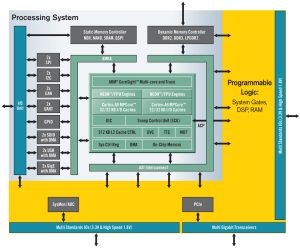Zynq All Programmable SoC System Architecture
Course Description
The Xilinx Zynq® All Programmable System on a Chip (SoC) provides a new level of system design capabilities. This course provides experienced system architects with the knowledge to effectively architect a Zynq All Programmable SoC.
This course presents the features and benefits of the Zynq architecture for making decisions on how to best architect a Zynq All Programmable SoC project. It covers the architecture of the ARM® Cortex™-A9 processor-based processing system (PS) and the connections to the programmable logic (PL) at a sufficiently deep level that a system designer can successfully and effectively utilize the Zynq All Programmable SoC.
The course details the individual components that comprise the PS: I/O peripherals, timers, caching, DMA, interrupt, and memory controllers. Emphasis is placed on effective access and usage of the PS DDR controller from PL user logic, efficient PL-to-PS interfacing, and design techniques, tradeoffs, and advantages of implementing functions in the PS or the PL.
 Level
Level
Embedded Architect 3
Course Duration
2 days
Audience
- System architects who are interested in architecting a system on a chip using the Zynq All Programmable SoC.
Prerequisites
- Digital system architecture design experience
- Basic understanding of microprocessor architecture
- Basic understanding of C programming
- Basic HDL modeling experience
Software Tools
- Vivado® Design or System Edition 2018.1
Hardware
- Architecture: Zynq-7000 All Programmable SoC*
- Demo board: Zynq-7000 All Programmable SoC ZC702 or ZedBoard*
* This course focuses on the Zynq-7000 All Programmable SoC. Check with your local Authorized Training Provider for the specifics of the in-class lab board or other customizations.
Skills Gained
After completing this comprehensive training, you will know how to:
- Describe the architecture and components that comprise the Zynq All Programmable SoC processing system (PS)
- Relate a user design goal to the function, benefit, and use of the Zynq All Programmable SoC
- Effectively select and design an interface between the Zynq PS and programmable logic (PL) that meets project goals
- Analyze the tradeoffs and advantages of performing a function in software versus PL
Day 1
- Zynq All Programmable SoC Overview
- Inside the Application Processor Unit (APU)
- Lab 1: Building a Zynq All Programmable SoC PlatformExamine the process of using the Vivado IP Integrator tool to create a simple processing system.
- Processor Input/Output Peripherals
- Introduction to AXI
- Zynq All Programmable SoC PS-PL Interfaces
- Lab 2: Integrating Programmable Logic on the Zynq All Programmable SoCConnect a programmable logic (PL) design to the embedded processing system (PS).
- Zynq All Programmable SoC Booting
- Lab 3: Using DMA on the Zynq All Programmable SoCExperiment with effectively using the PS DMA controller to move data between DDRx memory and a custom PL peripheral.
Day 2
- Zynq All Programmable SoC Memory Resources
- Meeting Performance Goals
- Lab 4: Impact of Port Selection on System PerformanceExplore bandwidth issues surrounding the use of the Accelerator Coherency Port (ACP) and the High Performance (HP) ports.
- Zynq All Programmable SoC Hardware Design
- Zynq All Programmable SoC Software Design
- Debugging the Zynq All Programmable SoC
- Lab 5: Debugging on the All Programmable SoCEvaluate debugging the hardware and software components of a Zynq All Programmable SoC design.
- Zynq All Programmable SoC Tools and Reference Designs
- Lab 6: Running and Debugging a Linux Application on the Zynq All Programmable SoCExplore a software application executing under the Linux operating system on the Zynq All Programmable SoC.
Lab Descriptions
- Lab 1: Building a Zynq All Programmable SoC Platform – Examine the process of using the Vivado IP Integrator tool to create a simple processing system.
- Lab 2: Integrating Programmable Logic on the Zynq All Programmable SoC – Connect a programmable logic (PL) design to the embedded processing system (PS).
- Lab 3: Using DMA on the Zynq All Programmable SoC – Experiment with effectively using the PS DMA controller to move data between DDRx memory and a custom PL peripheral.
- Lab 4: Impact of Port Selection on System Performance – Explore bandwidth issues surrounding the use of the Accelerator Coherency Port (ACP) and the High Performance (HP) ports.
- Lab 5: Debugging on the Zynq All Programmable SoC – Evaluate debugging the hardware and software components of a Zynq All Programmable SoC design.
- Lab 6: Running and Debugging a Linux Application on the Zynq All Programmable SoC – Explore a software application executing under the Linux operating system on the Zynq All Programmable SoC.

Datum
25 juli 2018 - 26 juli 2018
Locatie
Core|Vision
Cereslaan 24
5384 VT
Heesch
Prijs
€ 0,00
of
18 Xilinx Training Credits
Informatie
Training brochure
Registratieformulier
Registratie op aanvraag, neem contact op met ons.
